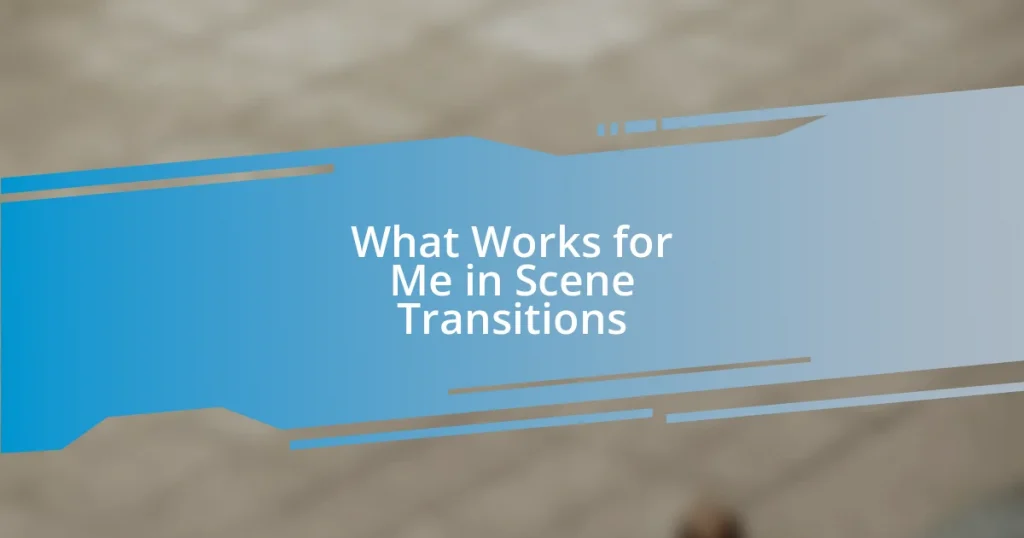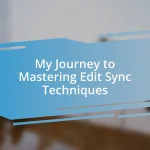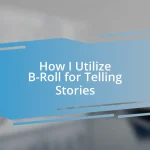Key takeaways:
- Effective scene transitions enhance storytelling by using sensory details, character perspectives, and emotional continuity to create a more immersive experience for readers.
- Smooth transitions maintain narrative flow, clarify context, and deepen emotional connections, thus allowing readers to process shifts in time and space.
- Common mistakes to avoid include relying on clichés, neglecting emotional continuity, and skipping transitions, as these can disorient readers and disrupt the narrative coherence.
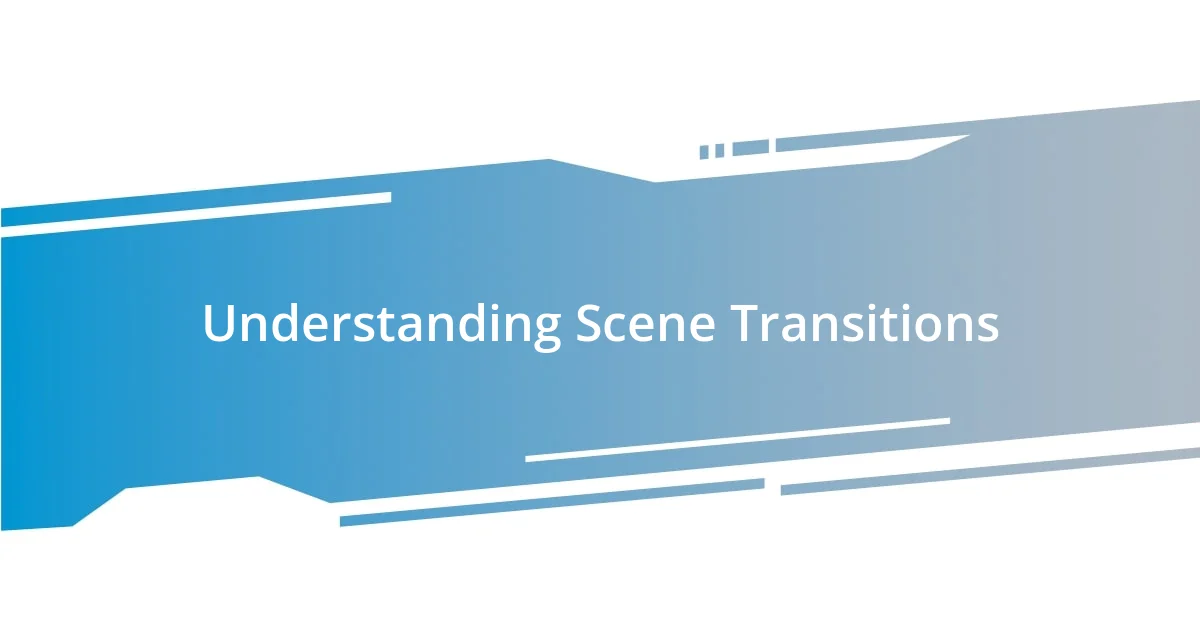
Understanding Scene Transitions
Scene transitions are critical in storytelling, serving as bridges that guide readers through shifts in time and space. When I first tackled scene transitions in my writing, I struggled with how to make these shifts feel natural instead of jarring. Have you ever jumped from one scene to the next and felt disoriented? I realize now that a well-crafted transition can weave continuity through your narrative, enhancing the reader’s experience.
One specific technique I found effective is using sensory details to anchor the reader in the new scene. For example, when transitioning from a bustling city street to a quiet forest, I might describe the noise of traffic fading away, replaced by the rustling of leaves. This shift not only creates a clear division between scenes but also evokes emotions tied to each setting. It’s fascinating how a few descriptive words can transport readers as if they’re taking that journey with you.
I’ve also discovered the power of character perspective in scene transitions. When a character reflects on their feelings during these shifts, it adds layers to the narrative. I once wrote a scene where a character moved from a joyous celebration to a lonely apartment, and their internal dialogue helped articulate the emotional contrast. Have you considered how your character’s mindset can enhance the reader’s understanding during transitions? This approach can deepen emotional connections and give your audience a reason to invest in the story.
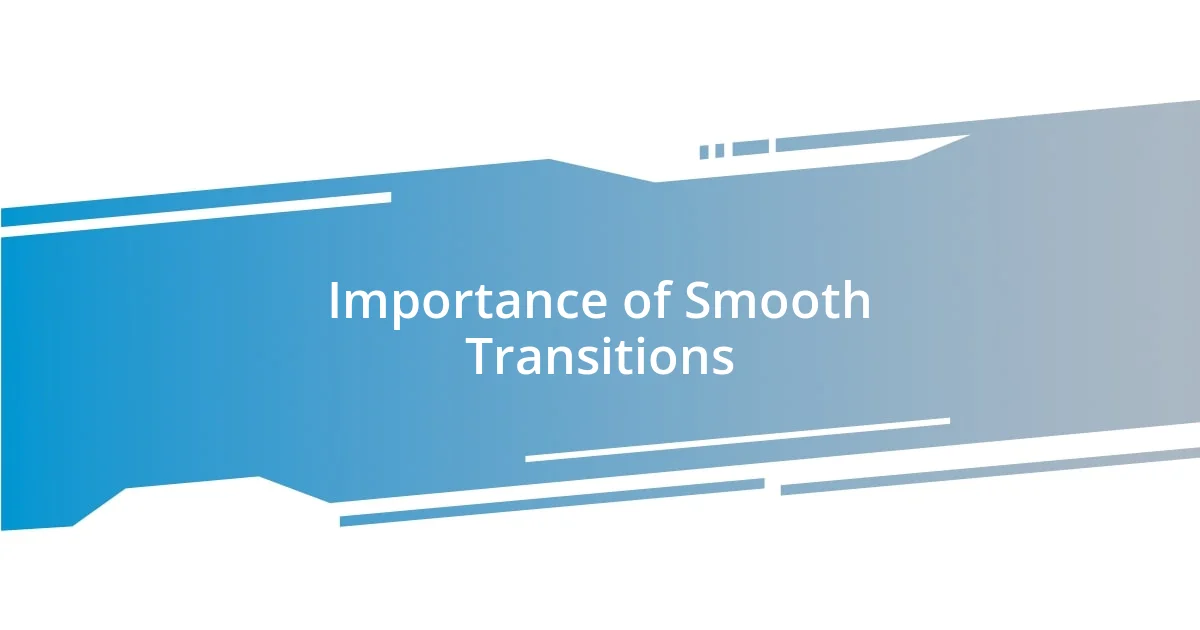
Importance of Smooth Transitions
Smooth transitions are vital because they ensure a harmonious flow within your narrative. I remember a time when I crafted a story filled with dynamic scenes, but my transitions were so abrupt that readers got whiplash. It became clear to me that without smooth transitions, the emotional impact of the story could be lost. A gentle segue allows readers to linger in the moment, processing the emotional shifts between scenes.
Here are a few key points to consider about the importance of smooth transitions:
- Maintaining immersion: Smooth transitions keep readers engaged, drawing them deeper into the world you’ve created.
- Clarifying context: They help clarify the relationship between scenes, so readers aren’t left wondering how one moment relates to the next.
- Enhancing emotional depth: Thoughtful transitions highlight the emotional stakes, making readers feel more connected to the characters’ journeys.
- Facilitating pacing: Using seamless transitions can help regulate the pacing of your narrative, allowing moments of tension to breathe and emotional impacts to resonate.
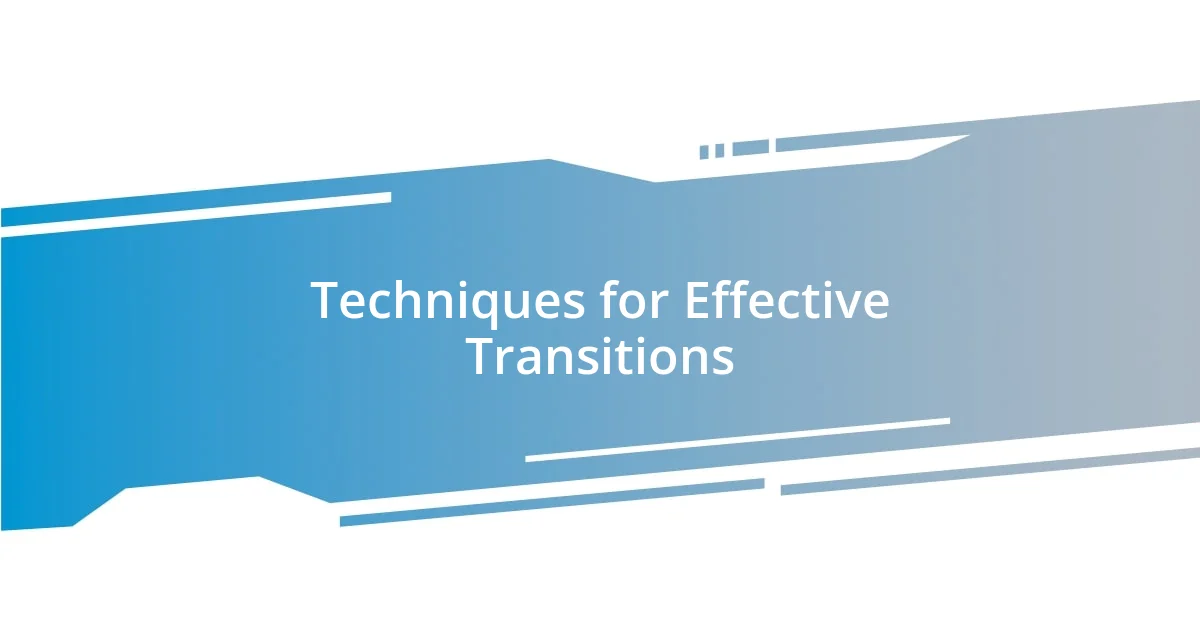
Techniques for Effective Transitions
One effective technique I often use in scene transitions is the “time jump” method. This involves establishing a clear point in time before moving forward or backward in the story. I once wrote a piece where I transitioned from a heated argument to a serene sunrise three days later. By indicating the passage of time, not only did it help the story feel more grounded, but it also provided readers with a breathing space to absorb the previous emotions. Have you considered using time jumps to shift your narrative while allowing your audience to digest the story’s pace?
Another method I’ve found increasingly useful is thematic linking. I remember crafting two scenes separated by vastly different settings but connected by a shared theme, like loss or hope. For instance, following a scene of a character grieving at a funeral, my next transition led to a celebratory gathering that symbolized rebirth. This contrast underscored the thematic depth and connected the emotional dots for the reader. By playing on themes, I invite readers to explore the intricate layers of my narrative. Have you tried thematically tying together your scenes for greater impact?
Here’s a comparison table to illustrate some effective techniques for transitions:
| Technique | Description |
|---|---|
| Time Jumps | Shifting the narrative forward or backward in time to allow readers to absorb emotional weight. |
| Thematic Linking | Connecting scenes through shared themes to create emotional resonance and depth. |
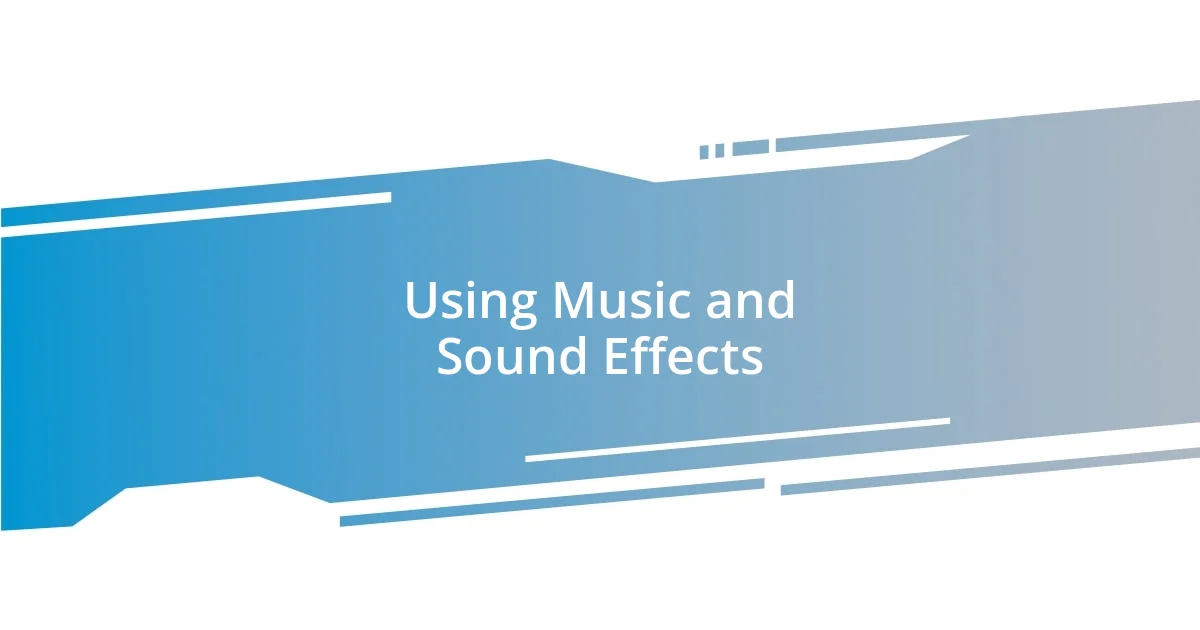
Using Music and Sound Effects
Nothing sets the tone for a scene quite like music and sound effects. In one of my earlier projects, I experimented with a haunting melody during a pivotal transition that showcased a character’s heartbreaking revelation. It was fascinating to see how the music enhanced the emotional weight of the moment, allowing readers to feel the character’s sorrow more deeply. Have you ever noticed how a single note can transport you back to a specific feeling? That’s the power of sound in storytelling.
When it comes to sound effects, I like to weave in subtle ambient noises to enrich the background of a scene. For instance, in a tense moment, I added the distant sound of raindrops to create a sense of isolation and foreboding. This layering helped to elevate the mood, making readers feel as though they were right there with the characters, bracing for the storm. Can sound effects really pull the reader into the world? Absolutely—they immerse readers in the atmosphere, making the experience more vivid and relatable.
On another occasion, I used a cheerful melody to transition from a winter scene to a summer picnic, and it was remarkable how effectively it conveyed warmth and happiness. This shift wasn’t just about changing the visuals; the music acted as a bridge that helped convey the emotional journey from one environment to the next. It’s a reminder that sound is not just background—it can shape our perceptions and feelings in powerful ways. Have you considered how integrating music or sound effects might transform your scene transitions? It’s worth experimenting with!
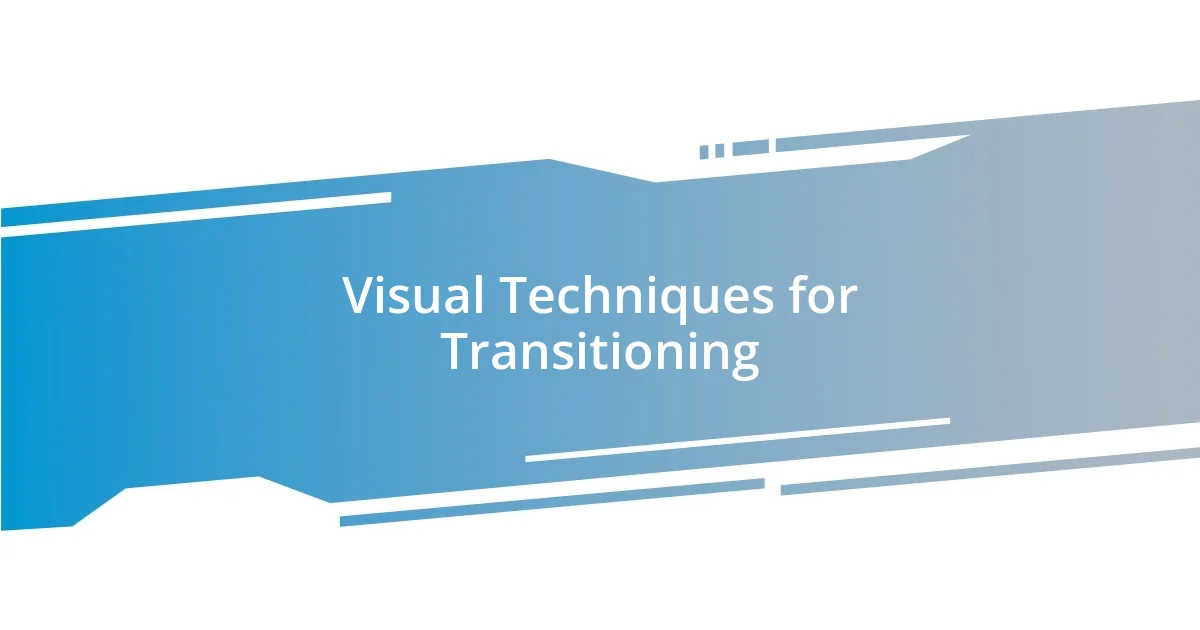
Visual Techniques for Transitioning
One visual technique that I’ve found to be very effective for transitioning scenes is the use of color grading. For instance, I worked on a project where I shifted from a desaturated, grey palette during a bleak scene to vibrant, warm colors for a moment of hope. This shift wasn’t just visually striking; it emotionally signaled a change in the narrative, allowing readers to feel an uplifting breeze after a storm. Have you considered how color can dictate the emotional tone of your scenes?
Another powerful element I often use is framing. I vividly remember a scene where I framed a character in a doorway, contemplating an important decision. As the scene transitioned, I pulled the camera back to reveal a bustling market outside, contrasting their inner turmoil with the vibrant life around them. This visual technique effectively highlighted the character’s isolation while also indicating a world full of possibilities beyond their struggles. By carefully choosing your frames, you can guide how readers perceive not just the action but the emotional stakes involved. Have you tried using framing to enhance your scene transitions?
Zoom effects can also create a captivating impact. In one narrative, I applied a slow zoom-in on a character’s expression, allowing the tension to build before revealing what they were looking at off-screen. This created anticipation and drew the reader’s attention to what was coming next. It’s fascinating how such a simple technique can heighten emotional engagement. Have you ever thought about how zooms can manipulate time and space in your storytelling? It’s something I encourage you to experiment with!
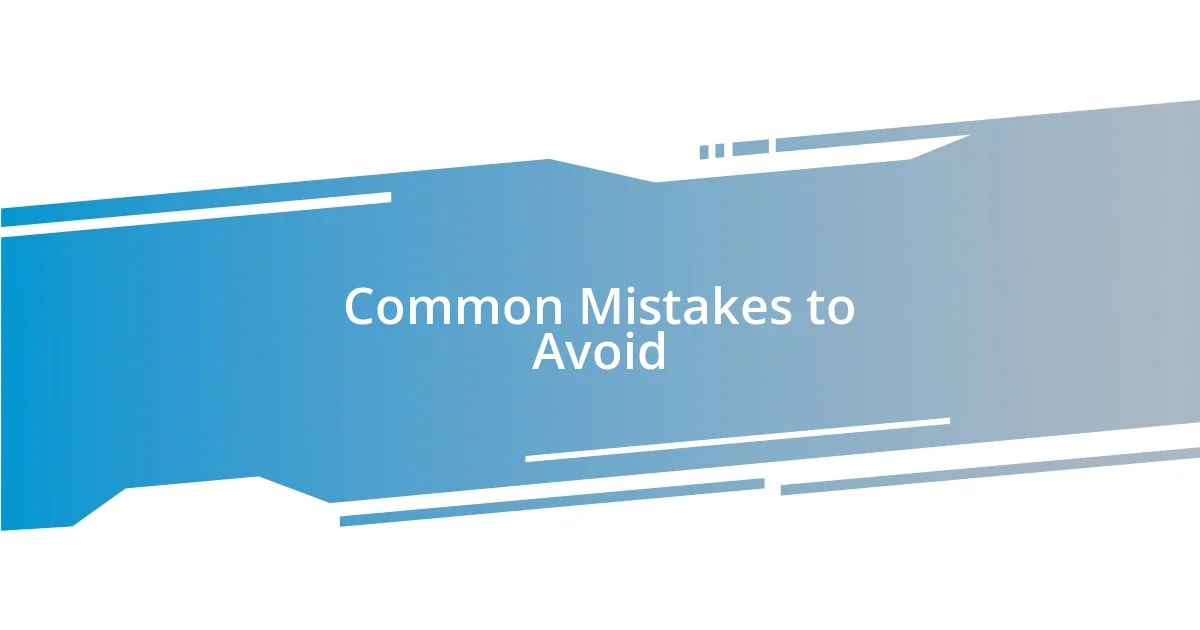
Common Mistakes to Avoid
When it comes to scene transitions, one common mistake I’ve noticed is relying too heavily on clichés. I once used a fade to black for a dramatic moment, only to realize later that it felt overdone and disengaging. Instead, exploring unique and creative methods can truly refine your storytelling. What if you tried a quick cut to an unexpected visual element? This could inject fresh energy into your transitions.
Another pitfall is neglecting the emotional continuity of your transitions. I remember a time when I jumped from a joyous celebration to a funeral without adequately bridging the emotional gap. It felt jarring and left my readers disoriented. Ensuring that the emotional thread flows consistently can keep your audience engaged and make each transition feel purposeful. Have you considered how pacing can help maintain this emotional journey?
Lastly, skipping transitions altogether can lead to confusion. In a rush to get to the next scene, I once moved from a tense confrontation to a serene park scene without any connective tissue. Readers were left scratching their heads, trying to make sense of the sudden shift. It’s essential to remember that thoughtful transitions guide your audience through the narrative. Have you found ways to cultivate smoother transitions in your storytelling? Taking that extra moment to craft them can significantly enhance your overall narrative coherence.











